

This provides a photo guide to some of the common visitors to the Sealey Butterfly Garden. If you click on the photo, it will provide more information about the caterpillar or butterfly.
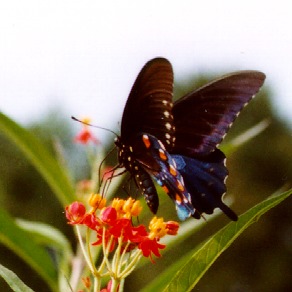 |
SPICEBUSH SWALLOWTAILS are frequent visitors to the garden and are identified by
their swallowtail shape with a bluish tint to their back inner wings. Caterpillars: Spicebush swallowtail caterpillars are fairly large and feed on spicebush and sassafras. They can be identified by two large black and orange fake eyes on the head and four lines of small blue dots down the body. Older caterpillars can be found in rolled up leaves in a silken mat. Chrysalis: They overwinter in a light green chrysalis with a brown stripe along the side Adults: Spicebush swallowtails can be up to 4 1/2 inches wide and are thought to be mimics of Pipevine swallowtails (which we haven't seen at Sealey yet!). It is thought that Spicebush swallowtails benefit from looking like Pipevine swallowtails because Pipevine swallowtails taste really nasty and so birds avoid both types. |
 |
GULF FRITILLARIES are a brilliant orange color. They are related to longwings because
their front wing is twice as long as their back wing. Caterpillars. The larvae are dark with reddish-brown stripes down their length. They are covered with branched spines and have two "horns" that curve backward from the head. They feed heavily on Passion Flowers, from where they get a poison that they retain in their body to reduce predation. Chrysalis: The chrysalis of the Gulf Fritillary is well camaflauged to look like a dried leaf. None of the life stages of Gulf Fritillaries can survive freezing temperatures and so these chrysalis must overwinter in Tallahassee in protected areas. Adults: The wingspan on these butterflies is around 3 inches, with dark spots on both sides and mirrored-silver spots on the bottoms. These butterflies are often mistaken as monarches, but they do not have the dark markings or size of monarchs. |
 |
LONG-WINGED TAILED SKIPPERS or BEAN-ROLLERS are one of the most common skippers on
the garden. Skippers are so named because of the unusual quick movements between
flowers. Caterpillars: The caterpillars feed on legumes (bean plants) and can be spotted because of the unusual shelter they make from either rolling the leaf or from cutting out a small section of the leaf and folding it over. Many can be seen on the weedy legumes on the sloping lawn along the eastern edge of the parking lot behind Sealey. The caterpillars can be found inside their little nests and are yellowish green with a dark reddish-brown head. They also have Chrysalis: Black Swallowtails overwinter as a curved, light green chrysalis held on to plants with a single thread. Adults: The wingspan on these butterflies is around 4 1/2 inches. Like the Spicebush Swallowtails, they are also thought to mimic the Pipevine Swallowtails as a way to discourage predators. |
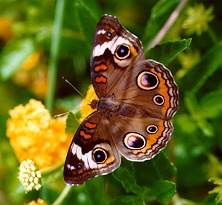 |
BUCKEYES are amongst our most beautiful butterflies. They are found throughout the
United States. Caterpillars: The larva are very spiny with 2 rows of orangish spots along the back and 2 rows of cream spots along the sides. The branced spines are black, with blue bases on the back spines and orange bases on the side spines. The legs are orange. Kind of a Halloween motif. They are many things and are even used by gardeners sometimes to control weeds. Chrysalis: Buckeye pupae are light cream with dark red-brown markings. Both larva and adults can overwinter if it doesn't get too cold. Adults: The inner wings each have two striking eyespots on a brown background. Buckeyes often bask in the sun and particularly like the Lantana in the Sealey garden. |
 |
GREAT PURPLE HAIRSTREAK is what we think this beautiful butterfly is. Hairstreaks
are beautiful small butterflies that hold their wings toghtly together over the back,
exposing the undersurface. Caterpillars: All hairstreak caterpillars have a distinctive short shape, with the legs often hard to see beneath the stubby body. The larvae feel primarily on mistletoe leaves found in live oaks. Chrysalis: The pupae are also very nondiscript, except that they are short and stubby. Adults: Many hairstreaks, such as this fellow attracted to the milkweed in the Sealey Garden, have long tails that the butterfly moves by rubbing his wings together. This causes the tails to look like legs, giving the illusion of a false head. This trick can help the butterfly when a predator strikes the tail, allowing the butterfly to escape. |
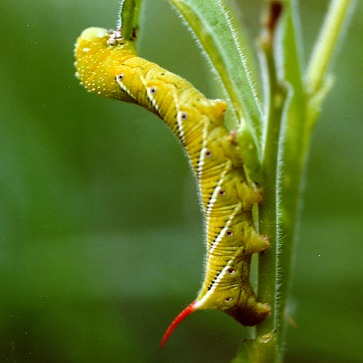 |
TOBACCO HORNWORM |
 |
LEAST SKIPPER? Skippers are a very different group from the rest of the butterflies.
Their name comes from their distinct, quick short flights. They are the only butterflies
that frequently hold the front wings up and their back wings at the side while resting. We are not sure about the identity of this particular common visitor to the Sealey butterfly garden. |
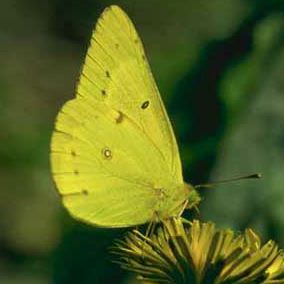 |
CLOUDLESS SULFUR are almost entirely yellow with a few large brown spots. It is so-named
because it is thought to occur on sunny "cloudless" days. They belong in
the giant sulphur group. Caterpillars. The caterpillars are green with a yellow stripe along each side. They can often be found in web "tents" on legumes, but also can be found in the open on Cassia, a favorite food plant. Chrysalis: The chrysalis is angled and green. Adults: The wingspan on these butterflies is around 3 inches and they are tremendous flyers. They are common during the winter in Florida, but may move north during the summer. Adults particularly like to feed on common weeds such as Agalinis and Ipomea. |
 |
MONARCH butterflies are one of the best known butterflies and are famous for their
long migrations and wintering grounds in the mountains in California and Mexico. Caterpillars: The Monarch caterpillars are white with yellow and green stripes, with pairs of thin "antenna" on both their head and tail. They feed and can be found almost exclusively on milkweed plants, from which they extract a poison which is distasteful to birds. Chrysalis: The rounded green chrysalis is green with shiny gold markings. Adults: Adults are common garden visitors and feed on a variety of plants. In Florida, monarchs make the remarkable trip to wintering grounds in Mexico, flying over the Gulf of Mexico. They can often be found along the shore in the fall before they begin their long trip over the ocean. Females mate at their overwintering grounds, then lay eggs on milkweed plants as they move north. |
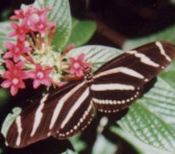 |
ZEBRA LONGWINGS are the state butterfly for Florida! They can't take the cold temperatures
and primarily occur in the tropics. Caterpillars: Zebra longwing caterpillars are white, with small black spots and long black branched spines. They feed primarily on passion flowers, from which they obtain a poison that keeps birds from eating both the caterpillars and the adult butterflies. Chrysalis: Mottled brown with spines. Adults: Zebra longwings are notoriously bad flyers, with ungainly wings that can be almost 4 inches across. They are commonly seen yards across Tallahassee, but especially in areas where there are passion flowers. They roost at night in large groups in trees -- supposedly, they sleep so soundly that you can pick them up without it waking. |
 |
RED ADMIRALS |
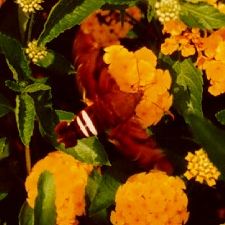 |
HUMMINGBIRD MOTHS |
For questions or comments
about this page, e-mail us at: jackandanna@yahoo.com